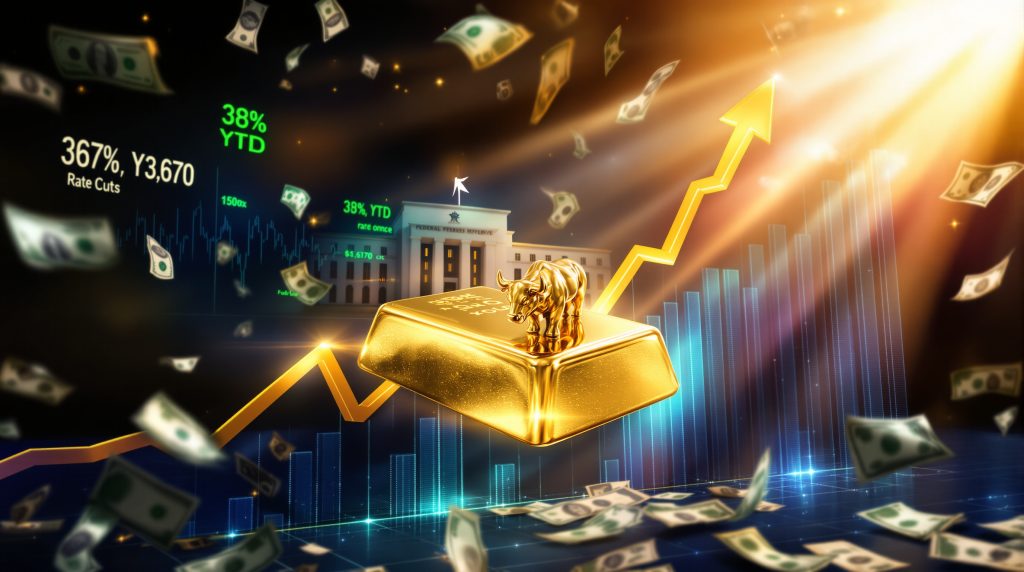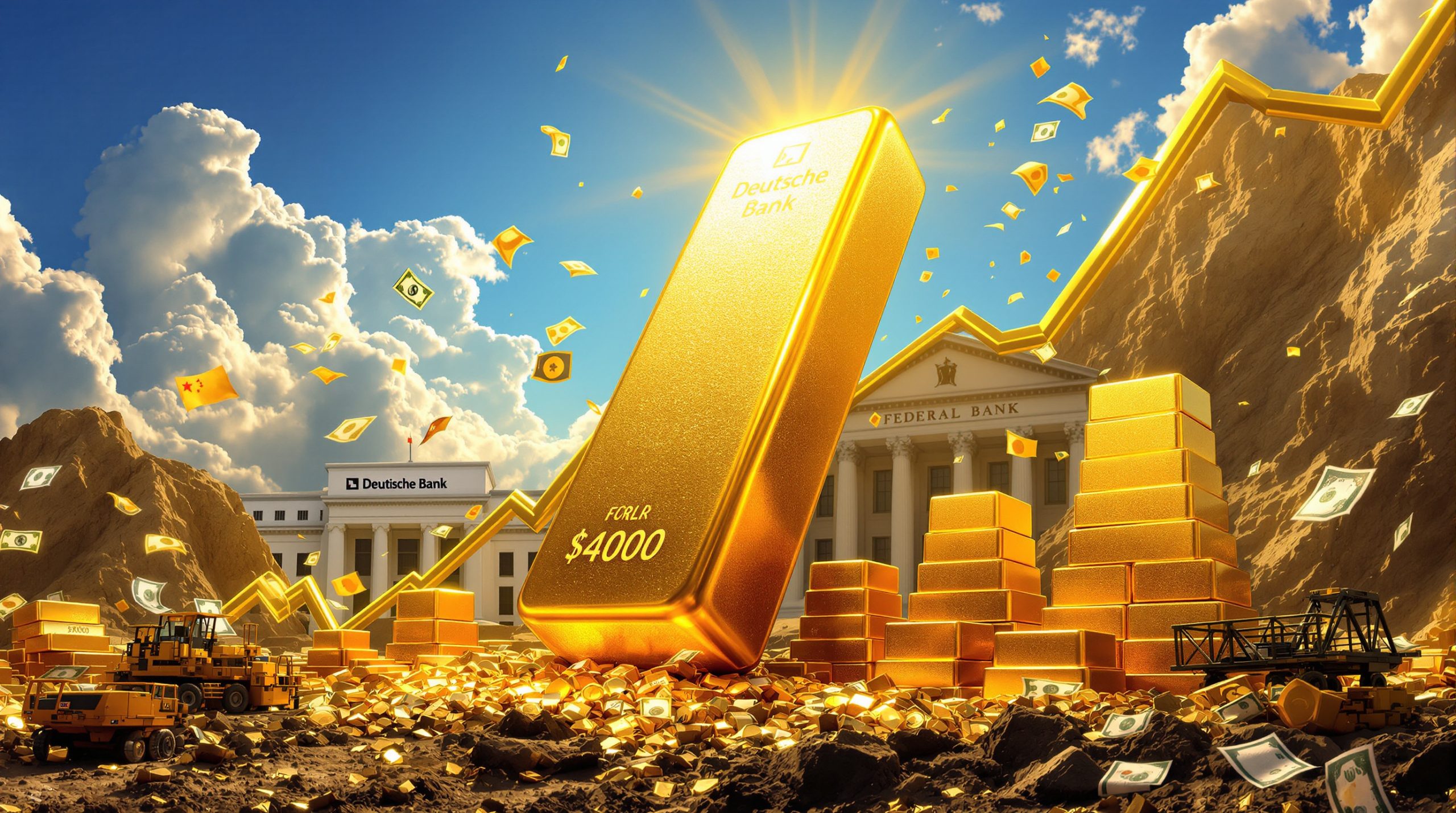Understanding Gold Prices in the Era of Fed Easing
As gold trades near unprecedented levels of $3,635 per ounce in September 2025, investors are closely watching how the precious metal responds to the Federal Reserve's anticipated pivot toward monetary easing. With year-to-date gains of approximately 38%, gold's performance reflects its traditional role as both an inflation hedge and beneficiary during periods of lower interest rates.
Current Gold Price Dynamics
Gold recently peaked at an all-time high analysis of $3,673.95, establishing strong support above the $3,600 level despite minor consolidation in recent sessions. The remarkable 38% surge since January represents one of the strongest yearly performances for gold in the past decade, outpacing most major asset classes.
Technical indicators suggest the metal remains in overbought territory by some metrics, but fundamental drivers continue to provide robust support. This paradoxical situation has created what analysts describe as a "momentum-driven market with fundamental underpinnings."
The December gold futures contract currently trades at $3,673.60, indicating market expectations for continued strength into year-end. This futures premium reflects institutional positioning that anticipates further upside despite the already substantial gains.
Market Sentiment Indicators
Trading volumes across major exchanges have remained elevated throughout the recent rally, with particular strength noted during Asian trading hours. This suggests widespread participation across global markets rather than regionally concentrated demand.
Investor positioning shows strong bullish momentum despite periodic profit-taking, with market depth analysis revealing substantial buy orders clustered around key technical support levels. This liquidity profile provides a cushion against sharp corrections, creating what traders refer to as a "price floor effect."
Why Is the September Fed Meeting Critical for Gold Investors?
The Federal Reserve's September 2025 policy meeting represents a pivotal moment for precious metals markets. Having paused its tightening cycle in January due to concerns about the inflationary impact of tariffs, the central bank is now widely expected to implement its first rate cut of the year.
Current Fed Rate Expectations
Markets have fully priced in a 25-basis-point reduction at the upcoming meeting, with CME FedWatch data showing over 95% probability of this outcome. A smaller but meaningful chance of a larger 50-basis-point cut remains in play, particularly given recent labor market weakness.
The current federal funds rate target range stands at 3.75-4.00%, having remained unchanged since January's policy pause. Analysts project the rate could fall to around 3.25% by year-end if the Fed follows through with its expected easing cycle.
Forward rate expectations derived from futures contracts suggest the market anticipates approximately 75 basis points of cuts before December, implying multiple policy moves in the coming months. This projected path would bring real interest rates (nominal rates minus inflation) closer to zero or potentially negative territory.
Economic Signals Driving Fed Policy
Weekly jobless claims have reached a three-year high at 263,000, signaling deterioration in labor market conditions. This weakening trend gained additional confirmation when recent revisions revealed 911,000 fewer jobs were created than previously reported in the 12 months through March.
While the unemployment rate remains relatively low by historical standards, the pace of job creation has slowed significantly, creating what economists call a "softening landing" scenario rather than an outright recession.
On the inflation front, core CPI remains elevated at 0.3% month-on-month, complicating the Fed's policy decisions. This persistence in core inflation despite cooling headline numbers creates a challenging environment for policymakers weighing growth concerns against price stability.
What Economic Data Is Shaping Gold's Current Trajectory?
Recent economic indicators have painted a complex picture of the U.S. economy, creating what many analysts consider an ideal environment for gold appreciation. The combination of persistent inflation alongside cooling labor market conditions strengthens the case for monetary easing.
Key Economic Indicators
August consumer price data exceeded expectations, showing the largest annual increase in seven months. This unexpected inflation persistence contrasts with the producer price index, which unexpectedly declined in August due to weaker trade services margins.
The divergence between consumer and producer prices suggests potential margin compression for businesses, typically a late-cycle economic phenomenon that precedes broader economic slowdowns. Historical analysis shows gold has performed exceptionally well during similar phases in previous cycles.
Employment data reveals a clear softening trend, with significant downward revisions to past job creation figures casting doubt on the labor market's underlying strength. This combination of job market weakness and sticky inflation creates what economists call a "stagflationary bias" – historically favorable for precious metals.
Market Interpretation
Investment flows indicate a growing rotation from growth assets toward traditional inflation hedges, with gold being a primary beneficiary. Portfolio managers increasingly cite concerns about both economic momentum and persistent inflation as drivers behind tactical allocation shifts.
The stagflation concerns present in current data create a scenario where the Fed may need to prioritize growth support over inflation fighting, potentially accepting higher inflation to prevent excessive labor market deterioration. This policy dilemma typically benefits gold prices and Fed easing expectations as it suggests real interest rates will remain low or negative.
How Does the Current Gold Rally Compare to Historical Patterns?
The 2025 gold rally stands apart from previous bull markets in both magnitude and the underlying macroeconomic context. Unlike previous cycles driven primarily by single factors, today's environment features multiple supportive elements converging simultaneously.
Historical Comparison
The 2022-2023 gold rally was driven primarily by geopolitical uncertainty and inflation fears but was constrained by aggressive Fed tightening. By contrast, the current rally benefits from both inflation persistence and anticipated monetary easing.
During the 2019-2020 surge, pandemic-induced monetary stimulus and safe-haven demand propelled prices, but the rally lacked the structural central bank buying present in today's market. Current central bank gold purchases are running at nearly twice the rate seen during that period.
The 2010-2011 bull market occurred amid post-financial crisis quantitative easing and sovereign debt concerns, similar to current conditions but without today's substantial physical demand from emerging markets and robust central bank buying.
Distinctive Features of 2025's Gold Market
Central bank purchasing has reached unprecedented levels, with official sector buying exceeding 800 tonnes annually as nations actively diversify away from dollar-denominated assets. This represents structural rather than cyclical demand, creating what analysts call a "permanent bid" in the market.
Physical demand remains robust in key markets like China and India despite higher prices, with premiums in Shanghai frequently exceeding $20 per ounce above global spot prices. This persistent demand despite price appreciation contradicts typical elasticity patterns observed in previous cycles.
ETF holdings have seen significant inflows after a period of outflows in previous years, reversing a multi-year trend and suggesting renewed institutional confidence in gold's longer-term prospects. Industry data indicates North American and European funds have added over 300 tonnes to their holdings year-to-date.
What Factors Beyond Fed Policy Are Driving Gold Prices?
While monetary policy expectations remain the primary catalyst for gold's recent performance, multiple additional factors have converged to create exceptionally favorable conditions for the precious metal.
Geopolitical Landscape
International tensions across multiple regions have heightened safe-haven demand, with gold benefiting from its traditional role as a crisis hedge. The metal's stateless nature and universal acceptance make it particularly attractive during periods of heightened geopolitical uncertainty.
Trade relationships have evolved significantly, with new tariff structures impacting both inflation and growth outlooks. These trade frictions introduce additional uncertainty into economic forecasts, typically benefiting perceived safe-haven assets like gold.
Currency dynamics, particularly dollar weakness against major trading partners, have enhanced gold's appeal to international investors. The currency effect essentially provides a discount for non-dollar buyers, stimulating additional demand from international markets.
Structural Market Shifts
Central bank reserves management strategies have fundamentally changed, with many nations actively diversifying away from traditional reserve currencies. This shift represents a multi-year structural trend rather than cyclical positioning, creating sustained demand that wasn't present in previous gold bull markets.
Mining production constraints have limited new output growth, with global gold production remaining essentially flat since 2018 despite higher prices. Industry analysts attribute this to declining ore grades, increased regulatory hurdles, and longer development timelines for new projects.
The declining ore quality across major gold-producing regions has particular significance for supply forecasts. Average ore grades have fallen by approximately 30% over the past decade, requiring miners to process more material for the same gold output and increasing production costs.
Technical Market Factors
Momentum trading strategies have amplified price movements, with trend-following algorithms adding significant buying pressure during breakouts above key technical levels. Market analysis indicates systematic traders have added over $10 billion in gold exposure during the current rally.
Options market activity reveals substantial hedging flows, with producers increasingly buying put options to protect against potential price declines while institutional investors purchase calls to gain leveraged exposure to further upside.
Physical delivery demands have created tightness in certain gold markets, particularly for specific bar sizes and specifications. This physical premium structure suggests underlying demand extends beyond paper market speculation.
How Might Gold Respond to Different Fed Policy Scenarios?
The Federal Reserve's decision and forward guidance will significantly influence gold's near-term trajectory. Three potential scenarios could unfold, each with distinct implications for precious metals markets.
Scenario 1: Moderate Easing Path
In this most likely scenario, the Fed implements a 25-basis-point cut while maintaining balanced forward guidance. Gold would likely continue its upward momentum but at a more measured pace, potentially reaching the $3,700-3,850 range by year-end.
Historical precedent suggests gold typically gains between 5-8% in the three months following the first rate cut of an easing cycle, particularly when inflation remains above target levels. This historical pattern supports the moderate upside scenario.
A gradual dollar weakening would likely accompany this scenario, providing additional support for gold as international buying power increases. Currency effects typically account for 15-20% of gold's performance during easing cycles.
Scenario 2: Aggressive Easing Cycle
Should the Fed implement a larger 50-basis-point cut or signal an accelerated easing path through unusually dovish forward guidance, gold could experience a more dramatic price surge, potentially testing the $3,850-4,000 range by year-end.
This scenario would likely trigger sharp dollar depreciation and yield curve steepening, both historically positive for gold prices. The combination of these effects could amplify gold's traditional response to rate cuts.
Institutional positioning would likely shift dramatically under this scenario, with systematic investment strategies increasing allocations to precious metals as a hedge against potential currency debasement concerns.
Scenario 3: Cautious Approach
If the Fed delivers a 25-basis-point cut but accompanies it with hawkish forward guidance suggesting limited further easing, gold could enter a correction or consolidation phase, with prices potentially retreating to the $3,500-3,700 range.
This scenario would likely result in dollar stabilization and profit-taking in gold positions, particularly among shorter-term speculative investors who have driven much of the recent price appreciation.
Technical support levels become particularly important in this scenario, with the $3,550 area representing a significant price floor based on previous consolidation patterns and the 50-day moving average.
What Are Expert Analysts Saying About Gold's Outlook?
Market analysts and precious metals specialists have increasingly adjusted their forecasts to reflect gold's exceptional performance and favorable macro backdrop.
Expert Perspectives
Independent metals trader Tai Wong notes that recent price movements point to some buyer fatigue, but gold's outlook over the next few months remains constructive, limiting the scope for a significant pullback. His analysis emphasizes the "structural underpinnings" supporting gold prices.
Major investment banks have revised price targets upward, with several now projecting year-end prices above $3,800. These revisions reflect the strength of the current rally and the favorable macroeconomic backdrop.
Commodity strategists highlight central bank buying as a particularly significant structural support factor. They note the diversification trends away from traditional reserve currencies have accelerated, creating sustained official sector demand.
Technical analysts identify potential resistance at the psychologically important $3,700 level, but most acknowledge the strong uptrend remains intact. The consensus view suggests pullbacks should be limited to the $3,550-3,600 support zone.
ANZ Research Insights
ANZ Research emphasizes fundamental drivers, noting that slowing growth, elevated inflation, and geopolitical shifts will continue to underpin investment demand. Their analysis suggests these factors create a "perfect storm" for gold appreciation.
Their research highlights continued strength expected from institutional allocations, particularly as portfolio managers seek inflation protection amid expectations for prolonged above-target price pressures.
ANZ's assessment of central bank activity points to ongoing diversification supporting a price floor for gold, making significant price declines unlikely even during short-term corrections.
How Can Investors Position for Gold's Next Move?
For investors seeking to capitalize on gold's current momentum or hedge against potential market volatility, several strategies warrant consideration based on individual risk tolerance and investment objectives.
Investment Vehicles
Physical gold offers direct exposure without counterparty risk, with coins, bars, and allocated storage options providing flexibility for different investment sizes. Premium differentials between product types have widened during the current rally, creating potential opportunities in specific segments.
Gold ETFs provide liquid exposure without physical storage requirements, making them ideal for investors seeking efficiency and low transaction costs. The largest funds now hold over 3,000 tonnes collectively, representing significant institutional positioning.
Mining equities offer operational leverage to gold price movements, potentially outperforming the metal itself during bull markets. Current industry fundamentals show improved capital discipline and margin expansion compared to previous cycles.
Options strategies provide defined risk approaches to capitalize on volatility, with put selling strategies generating attractive premiums in the current high-volatility environment for investors willing to accumulate on pullbacks.
Portfolio Allocation Considerations
Gold's historical negative correlation with traditional assets makes it valuable for diversification purposes. During the past five major equity market corrections, gold has averaged gains of approximately 7% while equities declined.
As an inflation protection tool, gold has historically maintained purchasing power during monetary easing cycles, particularly when real interest rates (nominal rates minus inflation) turn negative. Current forecasts suggest real rates could remain negative through 2026.
For volatility hedging, gold has demonstrated its ability to reduce overall portfolio risk during uncertain periods. Historical analysis shows adding a 5-10% gold allocation to a traditional 60/40 portfolio has reduced maximum drawdown by approximately 2-3 percentage points.
Currency diversification becomes increasingly important as monetary policy diverges globally. Gold's universal acceptance and liquidity make it an effective hedge against dollar depreciation for U.S.-based investors.
What Key Metrics Should Gold Investors Monitor?
As the Fed embarks on its easing cycle, several critical indicators will provide valuable insights into gold's likely trajectory and potential inflection points.
Primary Indicators to Watch
Real yields, measured as Treasury yields adjusted for inflation expectations, show the strongest historical correlation with gold prices. The 10-year real yield currently stands near 1.0%, with further declines likely to support additional gold appreciation.
The dollar index strength or weakness against major currency baskets directly impacts gold's price in dollar terms. Currency effects can account for 15-20% of gold's performance during major price moves.
Inflation breakevens, which reflect market-implied future inflation rates, provide insight into changing inflation expectations. The current 5-year breakeven rate stands near 2.4%, above the Fed's 2% target.
ETF flows serve as a reliable indicator of investment demand, with daily data providing near real-time insight into institutional positioning. Recent flows have turned significantly positive after a period of outflows in 2023-2024.
Secondary Factors
Physical premiums in key markets like Shanghai, Singapore, and India offer insights into regional demand dynamics. Current premiums in Shanghai frequently exceed $20 per ounce, indicating robust physical buying despite higher prices.
Futures market positioning reveals the balance between speculative and commercial interests. Current CFTC data shows speculative net long positions at elevated but not extreme levels, suggesting room for additional positioning.
Mining company guidance provides forward-looking production forecasts and cost structures. Recent industry presentations indicate flat to slightly declining global production over the next 2-3 years despite higher prices.
Central bank reserve statistics reveal official sector buying and selling activity. Quarterly data from the World Gold Council shows central banks have purchased over 400 tonnes in the first half of 2025, on pace to exceed 2024's record levels.
FAQs About Gold Prices and Fed Policy
How does a Fed rate cut typically affect gold prices?
Rate cuts generally support gold prices by reducing the opportunity cost of holding non-yielding assets. When rates decline, the relative disadvantage of gold's lack of yield diminishes, enhancing its attractiveness compared to interest-bearing investments.
Lower rates typically weaken the dollar, making gold more affordable for international buyers and enhancing its appeal as an alternative store of value. Historical analysis shows gold has gained an average of 5-8% in the three months following the first rate cut of an easing cycle.
The psychological impact of rate cuts often signals economic concern from central banks, increasing demand for perceived safe-haven assets like gold. This sentiment effect can sometimes outweigh the direct interest rate impact.
Why has gold performed so strongly in 2025 despite inflation moderating?
Gold's 2025 performance reflects multiple factors beyond inflation alone. The anticipated monetary easing cycle has created a favorable interest rate environment, with real yields declining despite moderation in headline inflation numbers.
Labor market weakness has increased expectations for accelerated Fed easing, benefiting gold through both the interest rate channel and safe-haven demand. Weekly jobless claims reaching three-year highs signal potential economic weakness ahead.
Central bank buying has provided structural support regardless of inflation levels. Official sector purchases are running at nearly twice the rate seen during previous years, reflecting strategic diversification rather than tactical inflation hedging.
Geopolitical tensions have increased safe-haven demand regardless of inflation levels. This risk premium typically remains in place until geopolitical situations stabilize, providing ongoing support for gold prices.
What would cause gold prices to reverse their upward trend?
A potential reversal could be triggered by unexpectedly hawkish Fed guidance suggesting concern about persistent inflation rather than slowing growth. This policy surprise would likely strengthen the dollar and increase real yields, both negative for gold.
Significant improvement in economic data, particularly employment figures, could reduce easing expectations and potentially trigger profit-taking in gold positions. Strong job creation would undermine the case for aggressive monetary easing.
Resolution of major geopolitical tensions would reduce the risk premium currently embedded in gold prices. Historical patterns suggest this effect can remove approximately 3-5% from gold's valuation during significant de-escalations.
Substantial profit-taking after the extended rally could create technical selling pressure, particularly if prices break below key support levels. The $3,550 area represents the first significant technical support based on the 50-day moving average and previous consolidation pattern.
How does gold typically perform during economic slowdowns?
Gold often outperforms during economic slowdowns, particularly when central banks respond with monetary easing. During the past four U.S. recessions, gold has averaged gains of approximately 20% from the start of GDP contraction to the end of the recession.
The metal's status as a store of value tends to attract investment during periods of uncertainty about growth prospects and financial stability. This safe-haven demand typically increases as economic data deteriorates and market volatility rises.
The monetary policy response to slowdowns, typically involving rate cuts and potential quantitative easing, creates a favorable interest rate environment for gold. Lower real yields reduce the opportunity cost of holding the non-yielding asset.
Corporate earnings deterioration during slowdowns often leads to equity market underperformance, increasing the relative attractiveness of gold as an alternative investment. This rotation effect can drive significant capital flows into precious metals.
What's the relationship between gold and silver prices during Fed easing cycles?
Silver typically exhibits higher volatility than gold during Fed easing cycles, often outperforming on a percentage basis when precious metals rally. The current gold-to-silver ratio stands near 87:1, above the long-term average of approximately 65:1, suggesting potential for silver outperformance.
This relationship reflects silver's dual nature as both a precious metal and industrial commodity. Monetary easing supports both aspects – the precious metal component through lower rates and the industrial component through anticipated economic stimulus.
Historical analysis shows silver has outperformed gold by an average of 2:1 during the first six months following initial Fed rate cuts in easing cycles since 1990. This pattern reflects silver's higher beta to monetary policy changes.
During periods of economic uncertainty, the gold-silver ratio typically rises as investors favor gold's more established safe-haven status. As economic outlook stabilizes, the ratio tends to decline as silver's industrial demand improves, suggesting a potential trading strategy based on economic cycle positioning.
Gold's Outlook Amid Monetary Policy Shift
As the Federal Reserve prepares to implement its first rate cut of 2025, gold stands at a pivotal juncture. The precious metal's exceptional year-to-date performance of 38% reflects a perfect storm of supportive factors: anticipated monetary easing, labor market softening, persistent inflation concerns, and robust investment demand.
While some consolidation appears likely after such a strong rally, the fundamental backdrop remains constructive for gold. The Fed's policy decision and forward guidance will be crucial in determining whether the current rally accelerates or enters a period of consolidation.
Structural factors—including central bank diversification, declining mine production, and portfolio hedging demand—suggest a favorable medium-term outlook regardless of short-term fluctuations. The combination of these elements has created what analysts describe as a "structural bull market" rather than a cyclical move.
Investors should remain attentive to evolving economic data and policy signals while recognizing gold's potential role in navigating the uncertainty that typically accompanies monetary policy transitions. The coming months may offer strategic entry points for those seeking to establish or enhance precious metals exposure as the Fed easing cycle unfolds.
Gold's performance during previous easing cycles suggests potential for additional gains, particularly if inflation remains persistent while growth continues to slow. This stagflationary bias typically creates the most favorable environment for precious metals, allowing them to outperform both defensive and growth assets.
For portfolio construction, the current environment warrants consideration of gold's historical role in reducing overall volatility while providing inflation protection. Whether as a tactical position or strategic allocation, gold's unique properties may prove particularly valuable as the economy navigates the transition to a lower interest rate environment.
Want to Stay Ahead of the Next Major Mineral Discovery?
Discovery Alert's proprietary Discovery IQ model instantly notifies investors of significant ASX mineral discoveries, turning complex data into actionable investment opportunities before the wider market reacts. Explore why historic discoveries can lead to substantial returns by visiting Discovery Alert's dedicated discoveries page and position yourself for potential gold-level opportunities.




